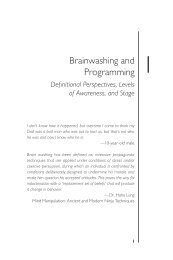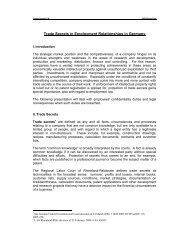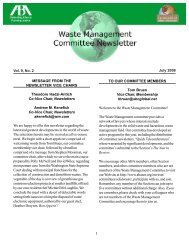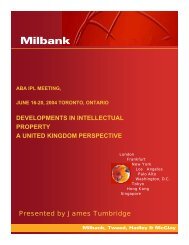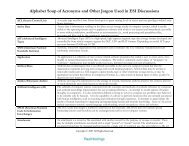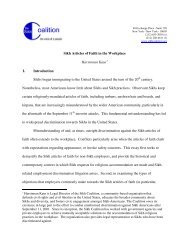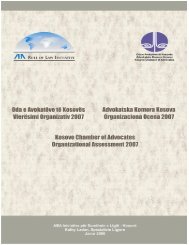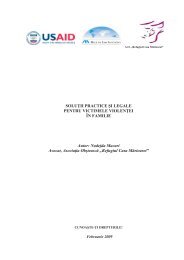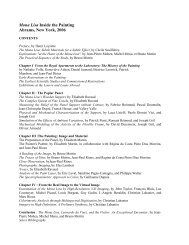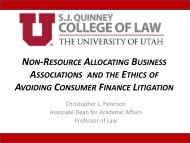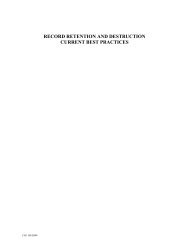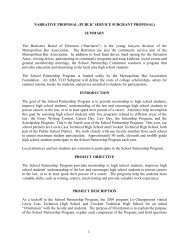Curing Defects in Stock Issuances - American Bar Association
Curing Defects in Stock Issuances - American Bar Association
Curing Defects in Stock Issuances - American Bar Association
You also want an ePaper? Increase the reach of your titles
YUMPU automatically turns print PDFs into web optimized ePapers that Google loves.
<strong>Cur<strong>in</strong>g</strong> <strong>Defects</strong> <strong>in</strong> <strong>Stock</strong> <strong>Issuances</strong> Under Delaware Law 1133<br />
Waggoner II also appeared to reject the possibility that the basis for the hold<strong>in</strong>g <strong>in</strong><br />
Triplex was equitable. The lower court found the equities supported validat<strong>in</strong>g the<br />
stock. The supreme court, on the other hand, determ<strong>in</strong>ed that the equities could<br />
not override the statutory violations that rendered the stock void.<br />
The rejection of equitable pr<strong>in</strong>ciples as a basis to validate defectively issued stock<br />
and the extension of Triplex <strong>in</strong> Waggoner II to statutory procedural defects <strong>in</strong> issuances<br />
were troubl<strong>in</strong>g because the supreme court raised the specter that a procedural<br />
violation <strong>in</strong> issu<strong>in</strong>g stock (even a type of stock that the corporation otherwise has the<br />
authority to issue) can render that stock void and <strong>in</strong>curable, even <strong>in</strong> circumstances<br />
where such a result is <strong>in</strong>equitable. Practitioners were thus left try<strong>in</strong>g to determ<strong>in</strong>e<br />
which procedures were “mere technicalities” and which were more than mere technicalities,<br />
thus potentially render<strong>in</strong>g the stock void. The case law afforded little<br />
clarity <strong>in</strong> how to make that “technicality” dist<strong>in</strong>ction. Which statutes were technicalities<br />
and which were substantive? Should violations of section 151 be treated differently<br />
than violations of, for example, section 161 (provid<strong>in</strong>g that the board only<br />
has the power to issue stock up to the number of shares authorized and which have<br />
not been subscribed for or otherwise committed to be<strong>in</strong>g issued) and section 152<br />
(permitt<strong>in</strong>g the board to issue stock for consideration hav<strong>in</strong>g a value at least equal<br />
to the par value of the stock be<strong>in</strong>g issued). S<strong>in</strong>ce all of the corporation statutes are<br />
to some extent technical, the court raised the possibility that any statutory violation<br />
could render stock void. For example, if stock is issued prior to the fi l<strong>in</strong>g of the<br />
certifi cate of amendment or the fi l<strong>in</strong>g of the certifi cate of designations creat<strong>in</strong>g the<br />
stock that otherwise has received all proper board and stockholder approvals, is it<br />
void or voidable? If stock is issued prior to the last director’s signature be<strong>in</strong>g placed<br />
on a board consent authoriz<strong>in</strong>g the issuance or the fi l<strong>in</strong>g of such consent with the<br />
board’s m<strong>in</strong>utes, is it void or voidable? Is the statement <strong>in</strong> Triplex about overissuances<br />
be<strong>in</strong>g curable still good law s<strong>in</strong>ce such an issuance would violate section 161,<br />
which goes to the power of the board to issue stock? From the practitioner’s standpo<strong>in</strong>t,<br />
<strong>in</strong> light of the broad language used <strong>in</strong> Waggoner II, it was very diffi cult to<br />
have confi dence that a defect was so trivial as not potentially to render stock void.<br />
Ten years after Waggoner II, the Delaware Court of Chancery issued, and the<br />
Delaware Supreme Court affi rmed without op<strong>in</strong>ion, a decision that permitted a<br />
defective stock issuance to be ratifi ed.<br />
KALAGEORGI V. VICTOR KAMKIN, INC.<br />
Like Waggoner I and Waggoner II, Kalageorgi v. Victor Kamk<strong>in</strong>, Inc., 137 was a section<br />
225 action. Thirty-n<strong>in</strong>e shares were held by pla<strong>in</strong>tiff Kalageorgi; sixty-one<br />
shares had been issued to the defendants. 138 The pla<strong>in</strong>tiff claimed to be the sole<br />
de jure stockholder because the sixty-one shares purportedly issued <strong>in</strong> 1990 and<br />
1991 to the defendants had not been validly authorized by the board of Victor<br />
Kamk<strong>in</strong>, Inc. (“VKI” or the “corporation”). 139 If the shares were validly issued, then<br />
137. 750 A.2d 531 (Del. Ch. 1999), aff’d, 748 A.2d 913 (Del. 2000) (unpublished table decision).<br />
138. Id. at 532.<br />
139. Id. at 536.



